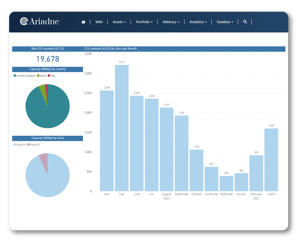
Calculate your ESG KPIs to Streamline the Reporting Process
This case study presents the successful implementation of an automated solution to calculate quarterly ESG (Environmental, Social and Corporate Governance) KPIs across a portfolio of 300 PV assets in four countries. The solution uses SCADA production data, electricity consumption, water consumption, pesticide use and diesel consumption to generate accurate and auditable sustainability KPIs. This solution optimised the KPI calculation process, reduced manual effort and improved the quality and transparency of the ESG assessment.
CONTEXT
The client, a leading renewable energy company, managed a portfolio of 300 PV assets spread across four countries. Assessing ESG KPIs in an accurate and auditable way was essential for meeting sustainability and transparency standards.
CHALLENGES
The client faced the following challenges:
- Data Complexity: Calculating ESG KPIs required data from a huge range of sources, such as production, electricity consumption, water consumption, pesticide use and diesel.
- Manual Calculations: Estimating annual KPIs was a complex and labour-intensive process that required the manual extraction of values from invoices and reports submitted by the operators.
- Data Auditing: The lack of an automated solution made it difficult to accurately audit the source of the data used to calculate ESG KPIs, and thus confirm the data's reliability.
SOLUTION
Quintas Analytics developed and implemented a complete automated solution to address the above challenges:
- Data Integration: A system was created to automatically collect SCADA production data, electricity consumption, water consumption, pesticide and diesel usage from ancillary services, invoices and operator reports.
- Calculation of the ESG KPIs: The solution calculated ESG KPIs based on predefined formulas and parameters, using data collected from different sources.
- Auditable Report Generation: The solution generated auditable quarterly reports which clearly showed the sources of the data used in the calculations.

RESULTS AND BENEFITS
Implementing the solution had a significant impact on both the quality and transparency of the ESG assessment and operational efficiency:
1. Reduction in Workload: Automation eliminated the need for manual extraction of the values needed for the calculation of KPIs from invoices and maintenance reports in various formats.
2. Improved Precision: The automated solution greatly reduced the risk of errors in KPI calculations.
3. Transparent Auditing: The reports generated clearly showed the source of the data used in the calculations, assisting the ESG audit process.
4. Compliance With Standards: The KPIs calculated were defined on the basis of the required sustainability and transparency standards.
5. Operator Efficiency: The management team was able to focus on strategic analysis rather than the repetitive manual tasks of data mining and KPI calculation.
CONCLUSIONS
Once implemented, the solution for the automated calculation of ESG KPIs in a diversified PV portfolio proved very successful in improving operational efficiency and transparency in sustainability assessment. Process automation, data collection and automatic calculations provided essential tools for effective, transparent and auditable management. This solution sets a valuable example for the management of similar solar energy projects in multiple localities.
